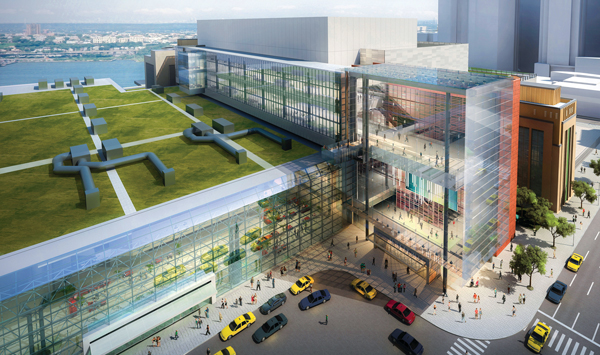In the history of the world, has there ever been an architectural type as uninspired as the convention center? Even the mention of those pallid words makes the mind fill with unwelcome images of boat shows and podiatrists gathering to talk shop and paint the town red.
So debased is the convention-center typology that, here in New York, bashing the Jacob K. Javits Center, on 11th Avenue between 34th and 40th streets, has become a civic pastime, one in which this writer has joined as enthusiastically as anyone. Everyone seems to agree that the 1986 building is unlovely and suboptimal — even its architect, James Ingo Freed of Pei Cobb Freed & Partners, was unhappy with the outcome.
Thus, many were optimistic — if cautiously so — when Gov. Andrew Cuomo announced plans for a 1.2-million-square-foot expansion last year. Given how widely despised the building is, it seemed that alterations could only improve the situation.
A few months ago, the project’s design-build team was finally selected, a collaboration between Lendlease and Turner Construction, with tvsdesign lending its aesthetic sensibility. The architectural team is being led by Robert Svedberg and Emery Leonard of tvsdesign, Brian Tibbs of Moody Nolan and Claire Weisz of WXY. The new spaces will include an additional 90,000 square feet of permanent exhibit space which, combined with existing space, can be configured into a 500,000-square-foot exhibition gallery. There will also be a 45,000-square-foot conference hall, a 55,000-square-foot ballroom — which, it’s said, will be the largest in the metropolitan area — and 27 new loading docks. But though it’s been known for decades that Javits would need an overhaul, all that time to mull possibilities clearly hasn’t paid off: the new design won’t significantly improve the aesthetics.

Claire Weisz
In criticizing both the existing Javits Center and the planned renovations, however, we have the responsibility not only to conceive of something better, but also to prove that it’s possible to build a better convention center. One would be hard pressed to point to a superior example. Certainly not McCormick Place in Chicago, despite its high Modernist credentials. Or Peter Eisenman’s Greater Columbus Convention Center in Ohio, in spite of Eisenman’s reputation as the high priest of Deconstructivist architecture. Something about the typology itself — essentially a cavernous shed designed to protect vast numbers of people from the elements — seems to militate against even the best architectural intentions.
Older New Yorkers will surely appreciate that, however unlovely the Javits Center may be, it is far more efficient and elegant than its predecessor, the New York Coliseum, which defiled Columbus Circle for nearly 50 years before its merciful demolition in 2000. So unloved was the Robert Moses-era Coliseum that in 1962, a mere six years after its completion, the city wanted to tear the whole thing down. Only municipal inertia and a rolling sequence of financial crises stalled plans to replace it for the next two decades.
The problem seems be with the convention center as type. It is a modern invention — nothing like it existed in antiquity. It presupposed, among other things, an ever-increasing specification of interests in society, as well as an infrastructure of transportation and information that could corral all those like-minded souls into one place. In the 19th century, when the typology was invented, architects designed such things somewhat better than we do today. The convention center was first created to mount the sundry World’s Fairs and Expositions Universelles that were such an important part of Western culture at the time. Pre-eminent examples of these buildings are the Palais de l’Industrie and the Grand Palais in Paris, the Crystal Palace in London and the Crystal Palace in New York, a massive piece of glass and steel that occupied what is now Bryant Park. The buildings were graced with all the bells and whistles — the grand stairways and Corinthian columns — of the Beaux-Arts tradition. What was successful about these structures was how well they concealed their function behind the trimmings of palace architecture.

Emery Leonard
There is no reason, of course, that such techniques could not be put into play again, but they are at great variance with the prevailing styles and architectural trends. Certainly nothing of the sort is in the offing with the new and improved Javits Center. Work began on the project in March, and the first order of business is a three-story structure that will contain generators, transformers and other mechanicals. The groundbreaking is a good sign that the project will come to fruition, unlike the plans for a Javits Center revamp unveiled in 2006. Designed by starchitect Richard Rogers with firms Fox & Fowle and A. Epstein & Sons International, those plans sought to integrate the Javits Center with the urban fabric of the Far West Side through the inclusion of much-needed trees and landscaping, among other amenities. If Mayor Michael Bloomberg hadn’t stepped in to quash the project, it would have resulted in a far more interesting reconception of the center’s design.
By contrast, the new design won’t change the existing structure; it will merely add several structures to the complex’s northern end.
Most of the aesthetic interest of the new design is limited to the enhancement of the two-block area between 38th and 40th streets, which now houses a mechanical shed and parking lot. Renderings suggest that more attention will be paid to opening up vistas of the Hudson River, in keeping with the city’s rediscovery of its waterfront, which was still spurned when the Javits Center opened three decades ago. Closer to the northern edge will be a tall, sheer box of a building, clad in an attractive curtain wall and housing a lofty atrium. This building will also include a balcony facing south, a nice touch that, like the new Whitney Museum, addresses the city’s real estate obsession — the desire to possess a commanding city view, if only for a few hours. Finally, at the very end of the lot will be a solid-looking and windowless structure that evocatively contrasts with the glassy transparency of its neighbor, even as it emphasizes a sense of connection with the impressive Art Deco power station across the street.
The new project is essentially an annex, and if it does not try very hard to harmonize with the pre-existing structure, it is not inharmonious, either. Unfortunately, the urban integration that was promised in the Rogers plan does not seem to have been a concern of the current designers, who appear to be solely concerned with expansion. The relation of the Javits Center, nearly a third of a mile in length, to the rest of the city will be exactly as it is now, and not nearly sufficient. At least the area’s ongoing development, especially the transformation of Hudson Yards to the south, may make the Javits Center feel a little less like an interloper than it does today. At a minimum, it will be a less obvious eyesore. As Frank Lloyd Wright said of the Coliseum when it opened 60 years ago: “It’s good enough for New York, as long as it doesn’t move anywhere.”
